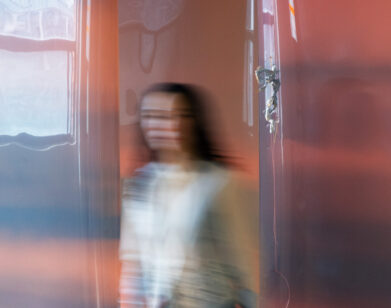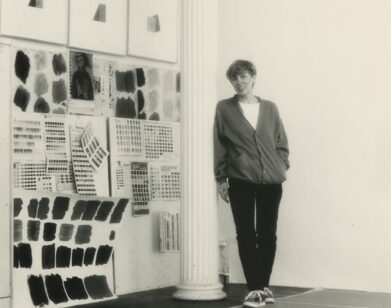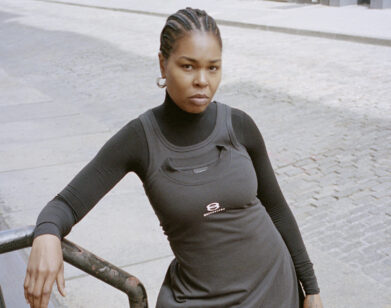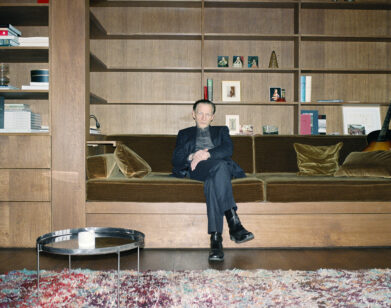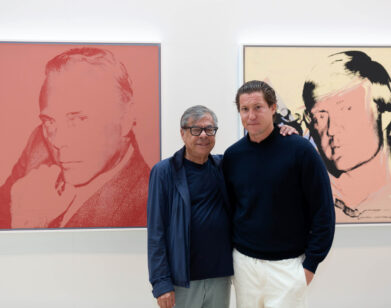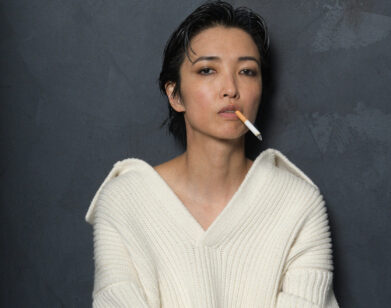IN CONVERSATION
Getting Up Close and Personal with Painters Emma McIntyre and Richard Hawkins
Born in New Zealand and now based in Los Angeles, the artist Emma McIntyre is no stranger to frequent travel. But the vibrant art scene of Hong Kong, the site of her second exhibition with David Zwirner, is a bit farther afield than even McIntyre ever imagined herself. Titled Among my swan, a name she’s borrowed from Mazzy Star, the show demonstrates the artist’s taste for chromatic abstractions that transcend the limits of language. “By introducing the swan motif,” McIntyre told Richard Hawkins last month, “I can connect to all the painted swans in art history.” She does so using oil paint alongside unconventional materials like oxidized iron, a gambit, Hawkins says, that suggests McIntyre’s granular attention to her artistic forbearers. “I think the difference is your investment in the history of painting,” he says, “but also how closely you look at other paintings.” Fresh off his own show at Hong Kong’s Empty Gallery, The Garden of Loved Ones, he and McIntyre got on a Zoom to discuss their shared obsessions: Baudelaire, art historian Michael Levey, and painting with your body, literally.
———
RICHARD HAWKINS: How was Japan?
EMMA MCINTYRE: It was so good. Have you been before?
HAWKINS: I lived there in ’99 and 2000.
MCINTYRE: Oh, you did?
HAWKINS: Yeah.
MCINTYRE: Whereabout?
HAWKINS: Mostly traveled around to Kyoto and Osaka.
MCINTYRE: Oh, cool.
HAWKINS: A little bit south. What did you guys do?
MCINTYRE: We were in Tokyo, then Kyoto, then Naoshima for a few days. Since you know Tokyo, you know you can’t achieve much in a few days—it’s huge. I feel like I barely scratched the sides. When did you get back from Hong Kong?
HAWKINS: More than a week ago. I had bad jet lag, but I had a great time.
MCINTYRE: Did you stay for the rave at Empty Gallery?
HAWKINS: No, no. My rave days are over.
MCINTYRE: You flew out that day, right?
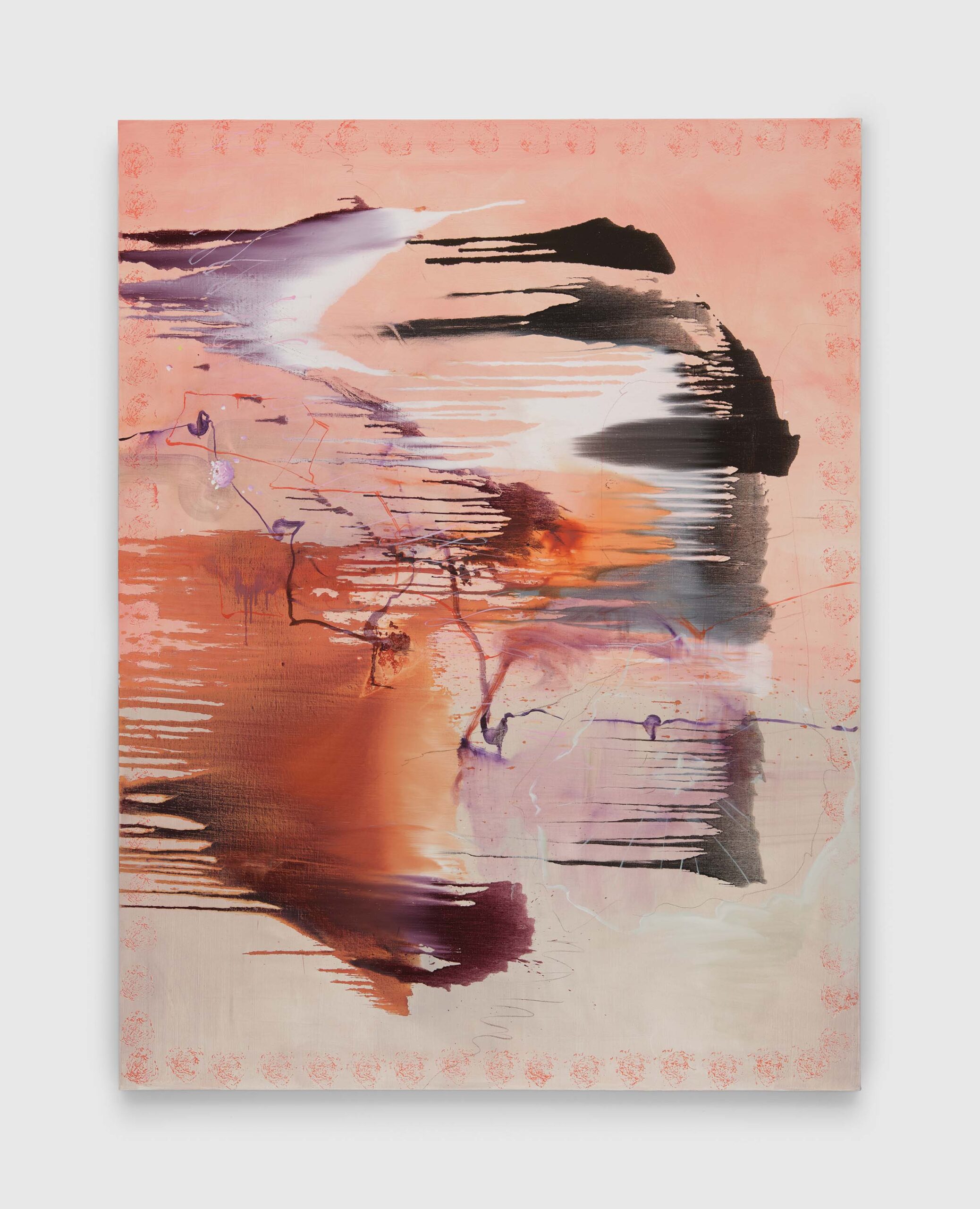
Emma McIntyre, Tiepolo pink, 2024. © Emma McIntyre. Courtesy the artist and David Zwirner.
HAWKINS: Yeah. I heard it was great. Those two sculptures of mine have lights inside that you can change, so they set them to disco.
MCINTYRE: Oh, amazing. So the rave was literally in your show.
HAWKINS: Not in the show proper, but yeah. I wanted to talk about your David Zwirner show called Among my swan. Do you want the opportunity to talk about your swan, singular?
MCINTYRE: My swan? Yeah. The title is actually, as you probably know, borrowed from a Mazzy Star album, so that’s one of the reasons for the singular swan. Now, in the notes that we exchanged ahead of this, you touched on a lot of swans that I have been looking at and thinking about.
HAWKINS: Oh, did I really?
MCINTYRE: You really did. I’d been looking at the Hilma af Klint swan painting—that was maybe the catalyst for the swans. I’d been looking for another motif from art history that could be a stand-in for the floral motif. By introducing the swan motif I can connect to all the painted swans in art history, and also the mythology of the swan.
HAWKINS: Hilma’s are more symbolic silhouettes of swans. I think they turn into flowers.
MCINTYRE: They have this amazing interlocking nature. I actually have a small painting I made for the show, which didn’t end up making the cut, which has that same silhouette. My swan forms are supposedly floating on a body of water, which distorts the spatiality of the painting, and I like that they’re always a little off. Their thin necks turn into snakes. I was also thinking about Leda and the Swan, and the many depictions of it in art history. I was thinking about that line about “Saucy Swans” from the book Rococo to Revolution.
HAWKINS: Is that the [Michael] Levey book?
MCINTYRE: Yeah, the Levey book.
HAWKINS: I’ve called it the “Nippy, super judgmental defenses of whimsy and delight.” Make that one of the best art history books that there are.
MCINTYRE: I love it. I was rereading it yesterday.
HAWKINS: What was the chapter of Levey that–
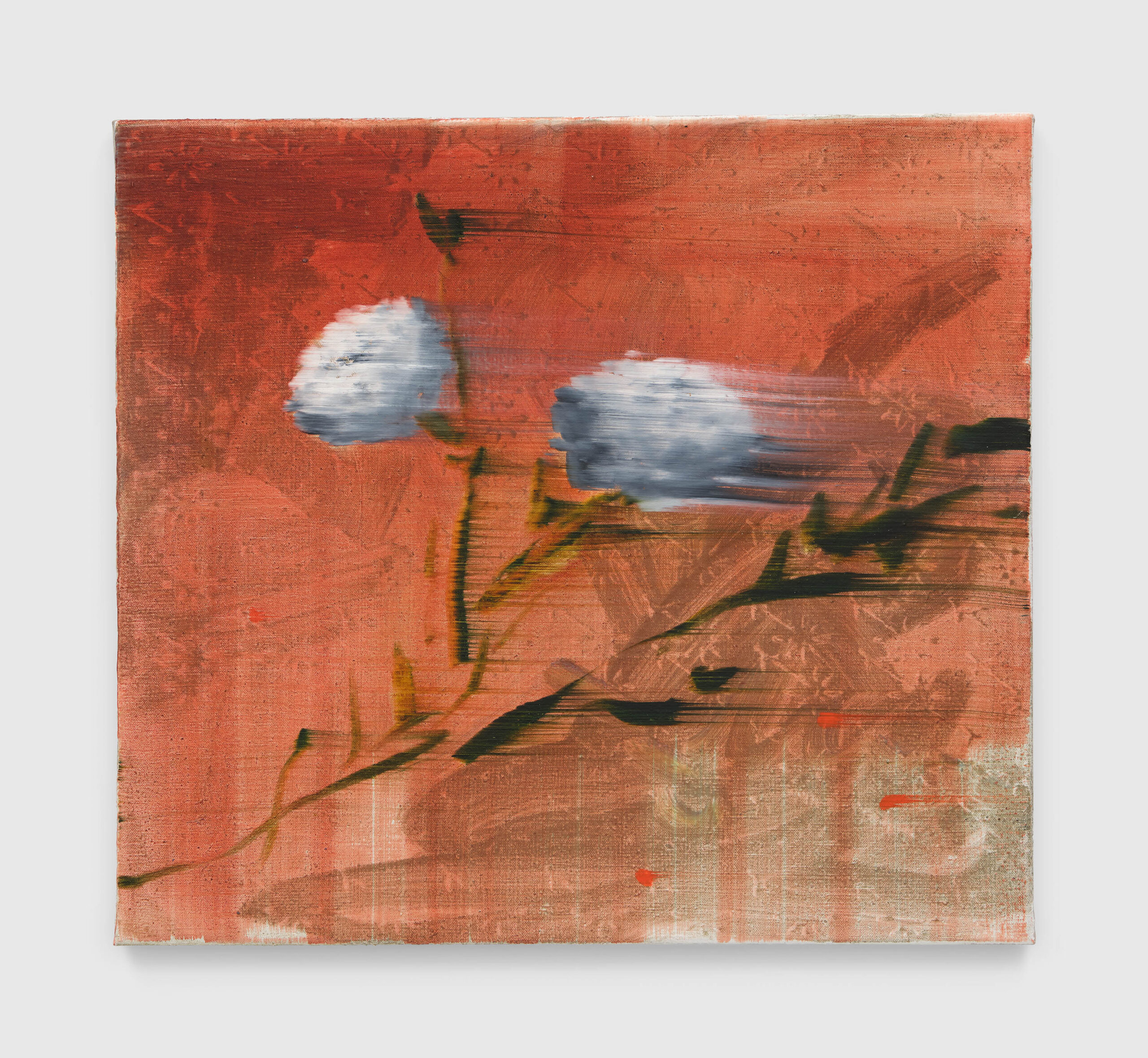
Emma McIntyre, Portals and altars, 2024. © Emma McIntyre. Courtesy the artist, Château Shatto, Los Angeles, and David Zwirner, New York.
MCINTYRE: I think it’s in the first chapter. It’s just him, in his lead up to getting more into Rococo, and then moving on to Watteau. He talks about Correggio’s Leda and the Swan painting as full of Rococo themes, while pre-dating Rococo of course, having being painted in the 16th century. He writes about the saucy swans, the languidness of the swans, and rape and bathing becoming one and the same pleasure in this particular work.
HAWKINS: One thinks of the word “sensuality,” but also “languorous,” and other kinds of poly… What’s the word? Polyphonic?
MCINTYRE: He also relates that body, the connection to water and the erotic, to being the starting point for some of those later Rococo paintings, like [Jean-Honoré] Fragonard’s foaming, frothy, spilling bodies of water, which I thought was interesting.
HAWKINS: I was thinking today that I did searches for Leda and feminine sexuality and I had forgotten that Michael Levey passage. What did I send you this morning? I sent you the [Antonio da] Correggio “Jupiter.”
MCINTYRE: Yes, exactly.
HAWKINS: I think the cloud is somehow related to the swan, but also Jan Weenix’s Dead Swan. Just looking at those, I ended up thinking that it’s a soft, plump volume. It would, for that period, stand in for the female body when you can’t show the female body. Like in that [Francois] Boucher that you and I share a love for that’s in the Norton Simon Museum. The elegance of the neck, you can think of as late as Modigliani, but also Parmigianino.
MCINTYRE: Yeah, exactly. I have to look at this beautiful Dead Swan while we talk about this.
HAWKINS: It makes the perfect object, male gaze swan. She’s not going to change her expression, despite the rape or violence. I was thinking that you were along the lines of a reclamation of Leda as an orgasmic female sexuality in excess or surplus.
MCINTYRE: That wasn’t necessarily my starting point for introducing the swan, but I love that. That’s where it begins to go, by introducing the swan and having those evocations of Leda and the Swan. I also love the Correggio that you sent me this morning with this atmospheric cloud as a sensual, erotic figure embracing the female form. I have so much atmosphere and cloud forms in my own work, so that feels quite apt.
HAWKINS: That one reminded me of your White chalk south against time.
MCINTYRE: Yes. Totally.
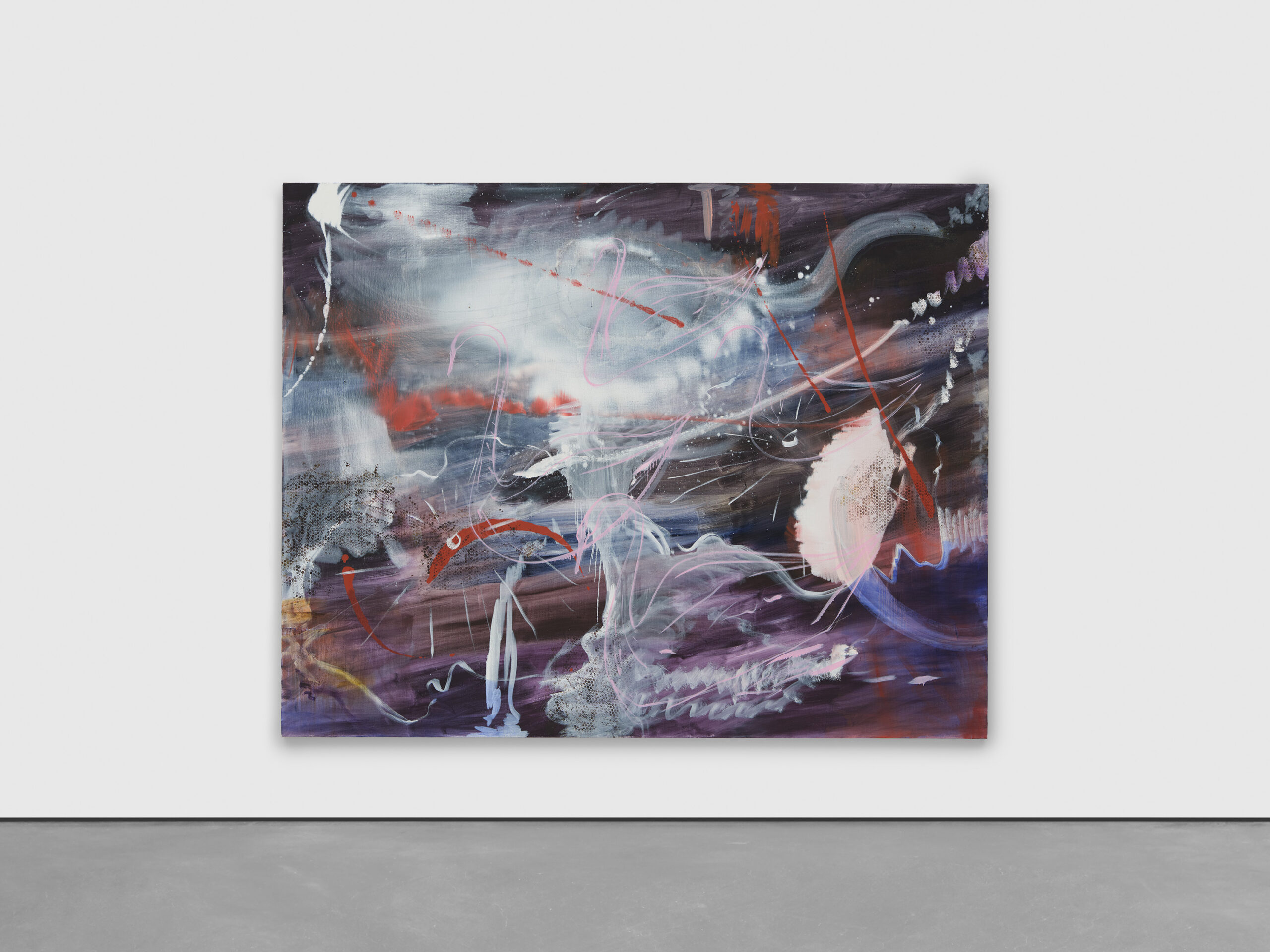
Emma McIntyre, White chalk south against time, 2024. © Emma McIntyre. Courtesy the artist and David Zwirner.
HAWKINS: Not that it formally looks like that, but there’s that great, gaseous thing from the upper left. Lots of splashes and jittering, repetitive marks and stuff, that reminded me of sexuality, more than anything else, I think.
MCINTYRE: Yeah.
HAWKINS: I’ve noticed that a lot of blurbs about your work have prematurely latched onto the oxidation process that you use. You’ve used it as color, the way that you would use paint. Is that its original purpose?
MCINTYRE: No, the iron paint that I use is a patina paint for your garden angel, or picture frame for example. The first layer of my canvas becomes metal, because it really is iron suspended in a binder, which is also what oil paint is – a metal or a mineral suspended in a binder. The difference is that I oxidize the iron paint with a chemical solution. But once I oxidize it, it becomes iron oxide, which is the basis for so many of the gorgeous pink browns that we both love. A lot of people see it as this outlier strand in my practice, but for me it feels pretty integrated.
HAWKINS: That’s what I was just reading about. It seemed like people latched onto that as like, “Aha! She doesn’t just use paint,” as if that’s the difference in your paintings. I think the difference is your investment in the history of painting, but also how closely you look at other paintings. I think you’re probably still excited about Watteau’s Embarkation to Cythera, but it’s as if you looked at every finger in every tree leaf in every painting and wondered how it was done. That’s what I see in the work.
MCINTYRE: Yeah, absolutely.
HAWKINS: Which is a dog whistle to painters to come join them, I think. Because writers will say, “Oh, it’s rust.”
MCINTYRE: Yeah. It’s easier to write about that than it is to think about how this particular brush stroke was applied in the 15th century.
HAWKINS: Do you want to talk a little more about Watteau and The Embarkation for Cythera?
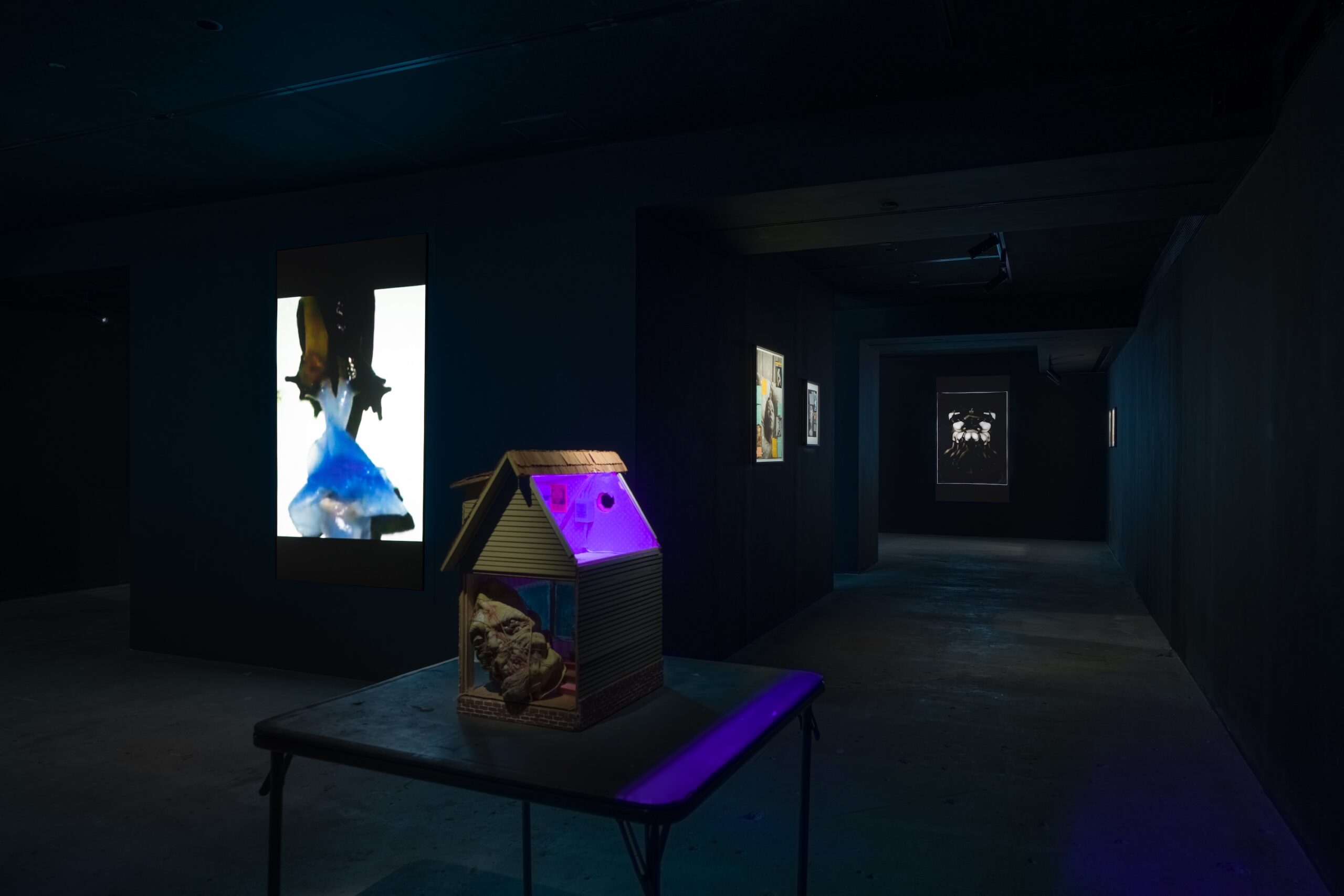
Richard Hawkins, The Garden of Loved Ones, March 23 – May 24, 2025, Empty Gallery, Hong Kong. Courtesy of the artist and Empty Gallery. Photography: Felix S.C. Wong.
MCINTYRE: Yeah. I was reading Rococo to Revolution, and Michael Levey talks about the fact that all of the characters in The Embarkation for Cythera are in masquerade costumes, which I hadn’t identified before. As Watteau’s works were so concerned with the human condition, he would often use the theater as a rupture point, to remove the image from immediate reality.
HAWKINS: It’s set up like a stage, like a big backdrop. Two layers of people, and then lots of foreground.
MCINTYRE: Exactly, which I love.
HAWKINS: We both were reading the Kuenzli book, which I have in front of me for the record. It’s Katherine M, Kuenzli: The Nabis and Intimate Modernism. When I was in Hong Kong, it was such a great time to meet entirely new people and colleagues. I’m not sure that the rest of our group, especially the curatorial writer section, are as convinced that decoration is not pejorative as much as you and I are. There was a pattern decoration movement–”decoration” with quotation marks. You really have adopted decoration as a very positive aspect of the work. Do you want to talk about that a little bit?
MCINTYRE: Yeah. Reading chapter five, I was thinking about Kuenzli’s framing of Vuillard as a decorative painter who was really making remarkable formal innovations in painting, which could be considered early modernism. It was more important to Vuillard to get this really beautiful and interesting patterning across this space that has these different discontinuities and dissonances than it was to accurately portray the female or male figure, their forms are dematerializing. And also these strange frames within the paintings, particularly in the panels that he made for Valquez. There are some really disorientating rectangles in there that just really mess with space. It’s like, how can people frame those works as unthinkingly decorative panel when they’re actually really unsettling and strange, and innovative with form? The world of decorative mark making and decorative motifs does feel still untapped territory to explore form. Because so many painters are so fearful of things being too decorative, or they’re doing the decorative in a really unthinking way. There’s this interesting area to explore, but my interest in the decorative does mean my work is sometimes misunderstood as too decorative and fluffy or whatever.
HAWKINS: In a pejorative way.

Richard Hawkins, The Garden of Loved Ones, March 23 – May 24, 2025, Empty Gallery, Hong Kong. Courtesy of the artist and Empty Gallery. Photography: Felix S.C. Wong.
MCINTYRE: Yeah, for sure. But I guess you always have your detractors.
HAWKINS: With everything. I was impressed by the Kuenzli book with the idea that you have to accept that middle class and bourgeoisie are also not pejorative terms, but that idea of the collector viewing a whole wall of Weard or Bonnard and kicking into a reverie of how flat the thing is, how democratically but idiosyncratically the paint is applied, is the purpose of the thing. Not representing a historical moment, or representing an idea of beauty. It’s for the eye to ponder upon, which I think is great. I think it would be difficult to train viewers to see things that way. The other thing I noticed is that people do a lot of appreciating your paintings from across the room. I think sometimes the smaller works operate as a way of establishing a vocabulary, and getting people prepared to look more closely at the larger ones.
MCINTYRE: Yeah, that’s true. That’s funny. At ArtCenter one of my tutors said to me, “You’re the only one who’s going to look so closely at the details in your work. Most people look from a distance.” I found that a really confusing thing to be told. Maybe it’s true, but why should I only care about how my paintings look from a distance? The viewers that I care about are going to be the viewers who are better at getting up close.
HAWKINS: Sticking their noses in it.
MCINTYRE: But as you know, I love the details the most.
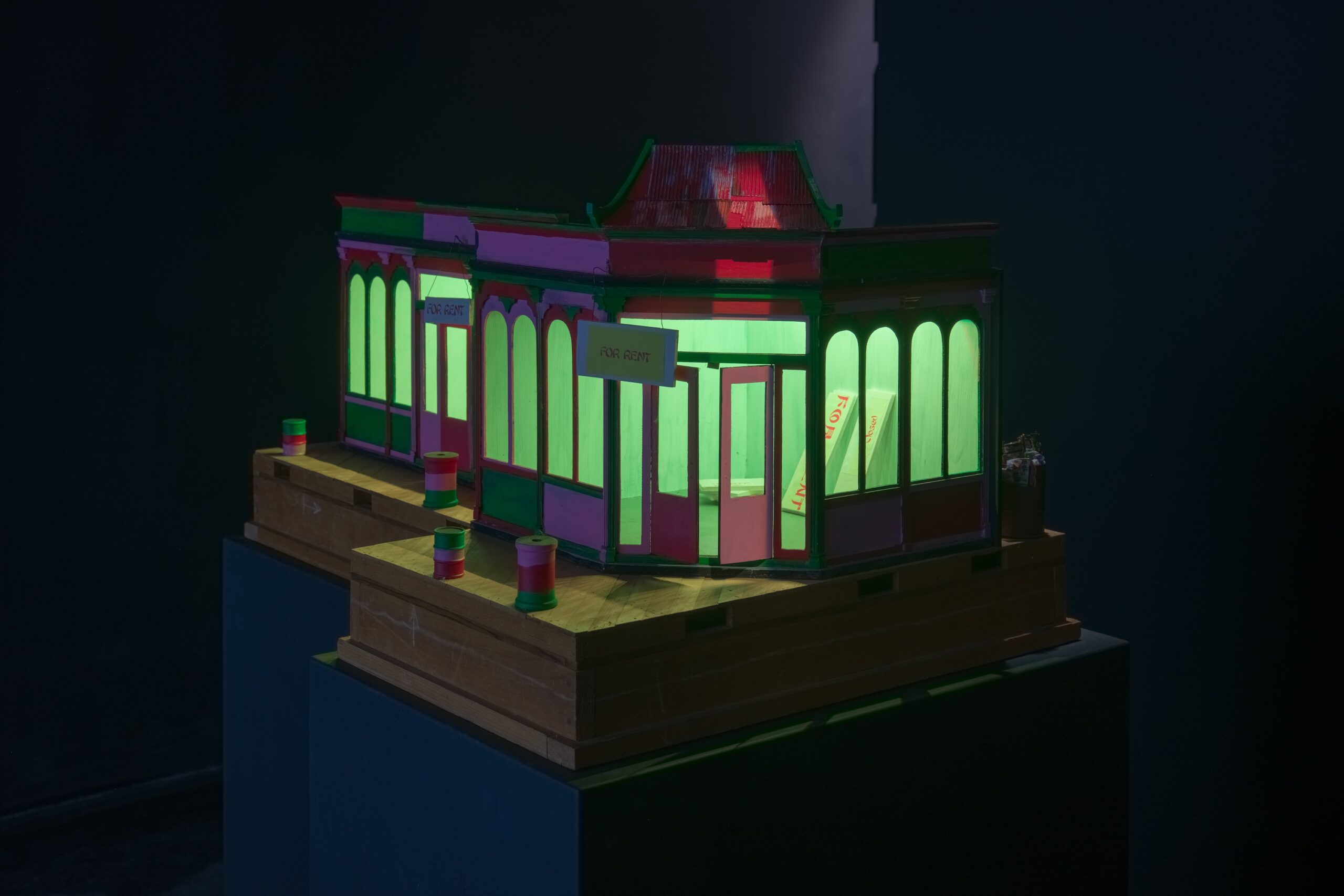
Richard Hawkins, The Garden of Loved Ones, March 23 – May 24, 2025, Empty Gallery, Hong Kong. Courtesy of the artist and Empty Gallery. Photography: Felix S.C. Wong.
HAWKINS: That’s how they become very idiosyncratic. That horizontal looping that you’ve done, it’s like calligraphy. But if you were in calligraphy class, you’d be getting a D-minus, right? The brush is all fucked up.
MCINTYRE: It’s so fucked up. I’m not very good at getting the same loop.
HAWKINS: But you are. You’re looking for the facture within the movement or something. To me, they’re idiosyncratic. To you, they wander off into nothingness. What is the painting that I mentioned earlier?
MCINTYRE: White chalk south against time?
HAWKINS: Yeah. That one is so tantalizing up close, as well as far. It seems like I wrote a little description of the line quality: little lines and dabs of finer brush stroke that make the smaller paintings so compelling. Is it public knowledge that you sometimes drip paint on fishnets and throw your boobs against the painting?
MCINTYRE: I don’t think so.
HAWKINS: Oh, well…
MCINTYRE: Now it is.
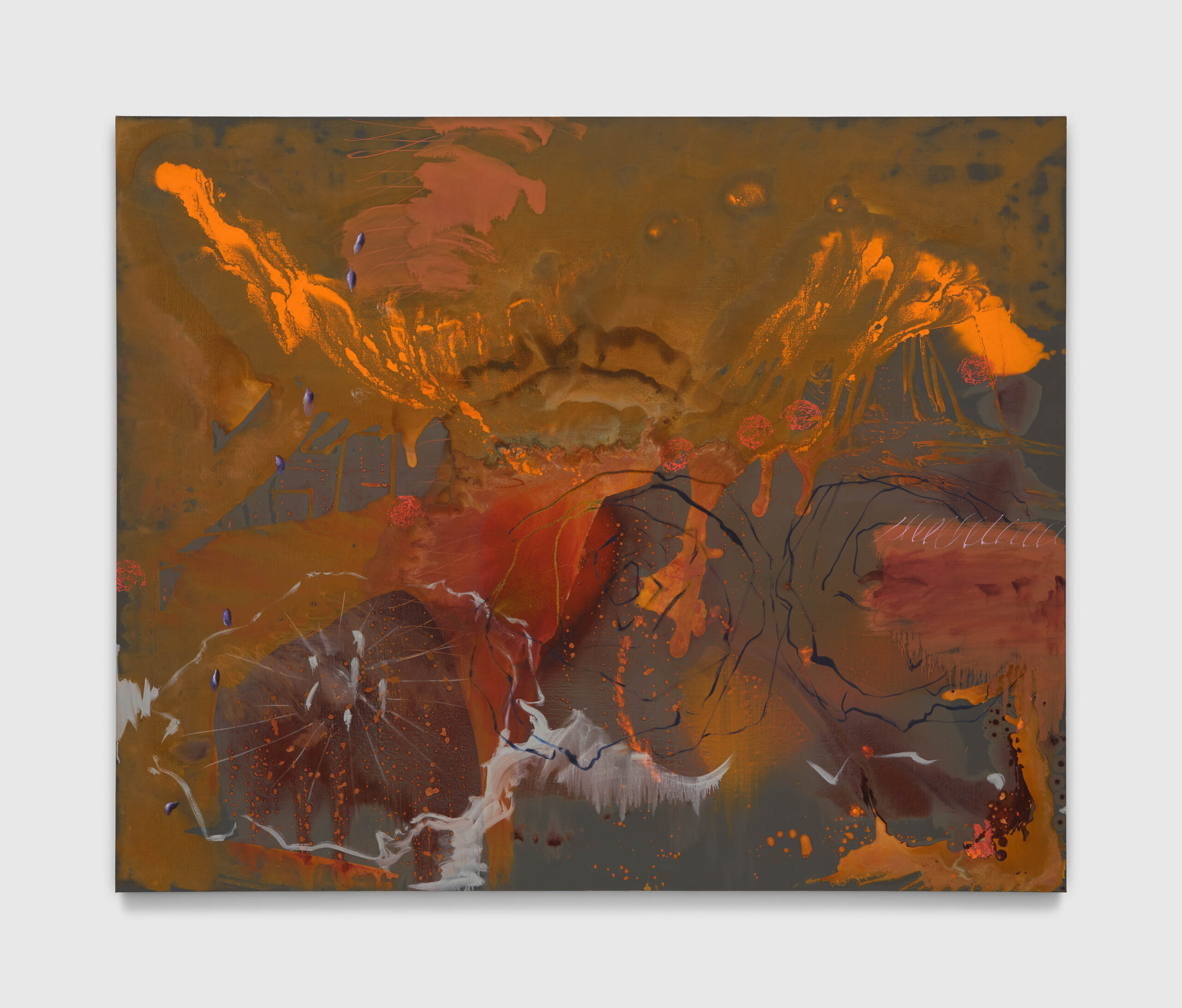
Emma McIntyre, Infernetto, 2024. © Emma McIntyre. Courtesy the artist and David Zwirner.
HAWKINS: That’s the first time I think I understood your work. We were looking at two round forms and you were like, “Oh, those are boobs.” I realized, not just sensually, but how actively involved you are in the process. It’s not just dabbing something on and stepping back, but you’re literally in the painting. Carolee Schneemann was the only artist lecture I ever went to, which was like 25 years ago. She brought me to tears of joy because she was describing how she was taking all of this straight male art history and putting it into her body, or letting her body tarnish or embellish in some way. It really affected me, her taking this entire history and being erotically involved with it. I know that you’re interested in Schneemann. Is that in the same ballpark?
MCINTYRE: Yes. A couple of years ago, I was looking closely at Fuses. I was really influenced by that work, the way that she was getting all this erotic sensuality through abstraction. Not just because the film strips were of her and her boyfriend having sex, but really the way she treated the material. This cutting and chopping and painting and all this tactile intervention into the film strip itself was, for me, the most sensual part of the piece. She writes so well about her process, and the way that she’s using art history and processing it through the body. I can’t really articulate it briefly, but she talks so much about the body-mind connection, really trying to break that down. I found that so inspiring. I want to approach my work sensually, through mind and body. I’m a thinking artist, and I’m reading a lot, and I’m looking at a lot of history. She was such a good guiding figure for the way go forth with my own way of processing art history.
HAWKINS: I know that I got pleasantly lost in knowing that you’ve always been interested in Watteau’s Cythera in particular. Then, in your painting Tiepolo Pink, I began to notice what I thought was manganese-violet, which is apparently a non-organic color intended to approximate the rarer version of tyrian-purple. Was it manganese that I was seeing?
MCINTYRE: I think so. I use manganese, so I’m sure it would’ve been. I love all those connections. I also have made all of those connections to Cythera. Of course, Cythera is supposedly the island near where Venus was born from sea foam, which makes sense, being the island of love. So yeah, I love that. And the Murex snails, from whose glands Tyrian Purple was extracted, are actually native to Cythera as well as to Crete.
HAWKINS: Makes sense.
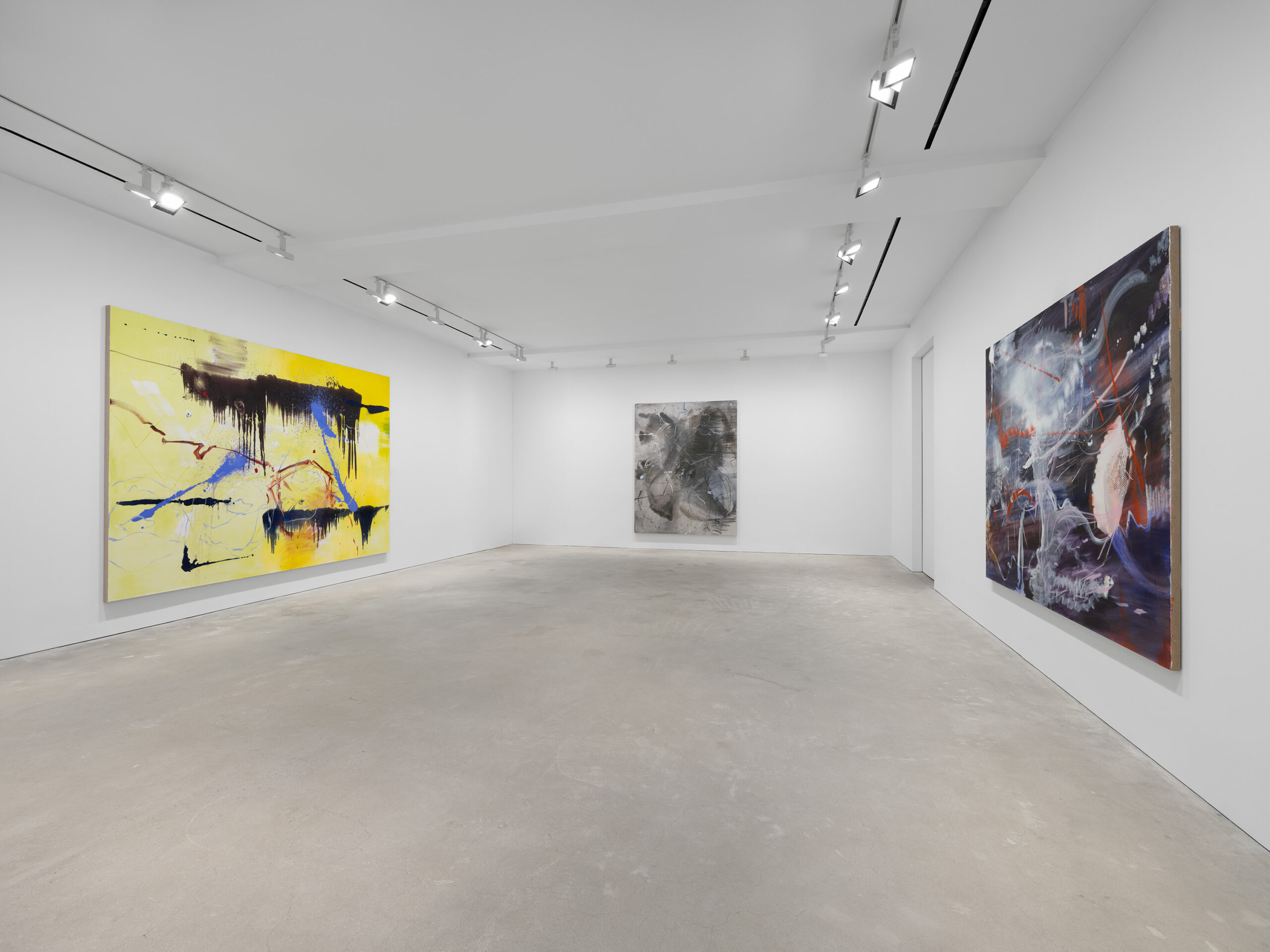
Installation view, Emma McIntyre: Among my swan, David Zwirner, Hong Kong, March 25—May 10, 2025. Courtesy David Zwirner.
MCINTYRE: They must’ve had these amazing processing areas that are stained with purple around the region, which then takes me to Twombly’s purple stain, and Sappho, and the mythology of Hyacinthus.
HAWKINS: I think you and I are fascinated by those connections.
MCINTYRE: Definitely. Are you familiar with the [Charles] Baudelaire poem about Cythera?
HAWKINS: Remind me.
MCINTYRE: How would I describe it? It’s like the horror after the love fest. It’s the barren island with the body hanging from the gallows, dripping blood whilst being eaten by birds and dogs. It’s pretty gnarly. But I thought that was a nice counterpoint to Watteau’s departure from Cythera.
HAWKINS: When I was talking earlier about the swan’s expressionless eyes as being the perfect previous history’s idea of what female consent was, I was specifically thinking of Baudelaire, where every woman’s eyes are a statue that doesn’t look back at you.
MCINTYRE: Yeah.
HAWKINS: Do you want to have the final word?
MCINTYRE: Oh god. I don’t know what my final word would be.
HAWKINS: Well then, we’ve already had it.


